Climate change is reshaping the Philippines in profound ways. As one of the countries most vulnerable to its effects, the nation faces significant environmental, economic, and social challenges. Rising temperatures, extreme weather events, and sea-level rise are already transforming landscapes and livelihoods.
For businesses, these changes present both risks and opportunities. Companies must adapt to shifting conditions while finding ways to contribute to resilience efforts. Strategic planning is essential to navigate this complex landscape and ensure long-term sustainability.
This article explores the multifaceted effects of climate change on the Philippines. It also highlights practical strategies for businesses and communities to build resilience. By understanding these dynamics, readers can better prepare for the challenges ahead.
Key Takeaways
- The Philippines is highly vulnerable to climate change, ranking among the most affected nations globally.
- Environmental, economic, and social sectors are all impacted by climate-related challenges.
- Businesses must adopt strategic approaches to adapt and thrive in this changing environment.
- Resilience and adaptation strategies are critical for long-term sustainability.
- Collaboration between communities, businesses, and governments is essential to address these issues effectively.
Understanding the Climate Change Context in the Philippines
Understanding the climate change context in the Philippines requires a deep dive into its historical and environmental factors. The country’s unique geographical location and socio-economic conditions make it a critical case study for global climate discussions. By examining historical data and key drivers, we can better learn how to address these challenges effectively.

Historical Overview and Data Trends
The Philippines has experienced significant environmental shifts over the decades. Since 1951, the average temperature has risen by 0.65°C, and sea levels have increased by 0.15 meters. These changes are compounded by the country’s exposure to natural disasters, with an average of 20 typhoons entering its waters annually.
Key milestones include Typhoon Haiyan in 2013, which caused over $3.64 billion in damages and displaced millions. Such events highlight the urgent need for comprehensive climate policies. The table below summarizes critical data trends:
| Year | Event | Impact |
|---|---|---|
| 2013 | Typhoon Haiyan | $3.64 billion in damages, 6,300 fatalities |
| 2021 | Typhoon Odette | $1 billion in damages, 630,000 displaced |
| 1951-2010 | Temperature Rise | 0.65°C increase |
| 1940-2023 | Sea Level Rise | 0.15 meters increase |
Environmental and Social Drivers
Environmental drivers such as deforestation, urbanization, and industrial activities have accelerated climate change in the Philippines. For instance, coal and fuel oil account for over 41% of the country’s greenhouse gas emissions. These factors, combined with rapid population growth, exacerbate the nation’s vulnerability.
Social drivers, including community practices and informal settlements, also play a significant role. Approximately 45% of the urban population lives in areas prone to flooding and typhoons. Understanding these drivers is essential for developing effective resilience strategies.
By studying these trends, policymakers can create targeted interventions. Collaboration between communities, businesses, and governments is crucial to mitigate the effects of climate change and ensure long-term sustainability.
Evaluating the Impact on Public Health and Livelihoods
Public health and livelihoods in the Philippines are under threat from climate-related changes. Rising temperatures, extreme weather events, and shifting environmental conditions are creating new challenges for communities across the nation. Understanding these issues is essential to develop effective solutions.
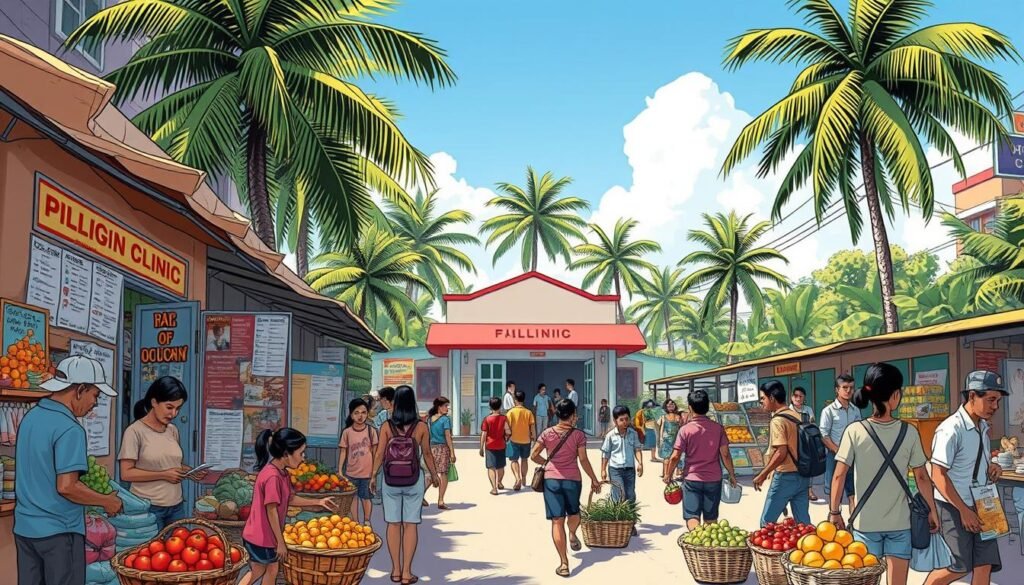
Health Risks and Community Vulnerabilities
Climate change poses both direct and indirect health risks to Filipino communities. Rising temperatures increase the spread of diseases like dengue and malaria. Extreme weather events, such as typhoons, disrupt healthcare access and worsen existing conditions.
Remote and underdeveloped areas are particularly vulnerable. Limited infrastructure and resources make it harder for these communities to respond to health crises. For example, during Typhoon Haiyan, many rural areas struggled to access medical aid.
To discover effective solutions, policymakers must focus on strengthening healthcare systems. Community-based programs can also play a key role in building resilience.
Economic Challenges and Adaptation Needs
Climate change is disrupting livelihoods across the Philippines. Farmers face unpredictable weather patterns, leading to crop failures and income loss. Small businesses in coastal areas are also at risk due to rising sea levels and flooding.
Households in vulnerable areas often struggle to recover from climate-related disasters. For instance, many families displaced by Typhoon Odette are still rebuilding their lives. These economic challenges highlight the need for adaptive strategies.
Emerging programs, such as community-based adaptation initiatives, are showing success. These efforts focus on sustainable practices and local empowerment. By providing insight into effective strategies, they offer hope for long-term resilience.
Collaboration between communities, businesses, and governments is essential. Together, they can address these challenges and create a more sustainable future for the Philippines.
Climate Change and Ecosystem Degradation
The Philippines’ ecosystems are facing unprecedented challenges due to climate change. Rising temperatures, extreme weather, and sea-level rise are disrupting habitats and threatening biodiversity. These changes are not only environmental but also have far-reaching social and economic consequences.

Biodiversity Loss and Habitat Disruption
Climate change accelerates biodiversity loss by altering critical habitats. Endemic species, such as the Philippine eagle and tarsier, are at risk. Natural reserves, like the Tubbataha Reefs, are also under threat. These changes reduce the resilience of ecosystems and their ability to support life.
Over time, habitat disruption has led to the decline of many species. For example, deforestation and urbanization have fragmented forests, making it harder for wildlife to thrive. This loss of biodiversity affects the entire world, as the Philippines is a global hotspot for unique flora and fauna.
Water Resource and Coastal Erosion Issues
Water resources in the Philippines are degrading due to increased salinity and pollution. Coastal erosion is another major concern, undermining local economies and settlements. Communities relying on fishing and tourism are particularly vulnerable.
Coastal areas, such as Palawan and Cebu, are experiencing significant land loss. This not only displaces families but also disrupts ecosystems like mangroves and coral reefs. These changes highlight the urgent need for sustainable water management and coastal protection strategies.
Environmental marketing plays a crucial role in raising awareness about these issues. By educating the public, businesses and governments can work together to protect ecosystems and ensure long-term sustainability.
Resilience Strategies from Local to National Levels
Building resilience against climate change in the Philippines requires coordinated efforts from local communities to national governments. From grassroots movements to strategic policies, these initiatives aim to address the growing challenges posed by environmental shifts. By fostering collaboration and innovation, the country is taking significant steps toward sustainable growth and long-term resilience.
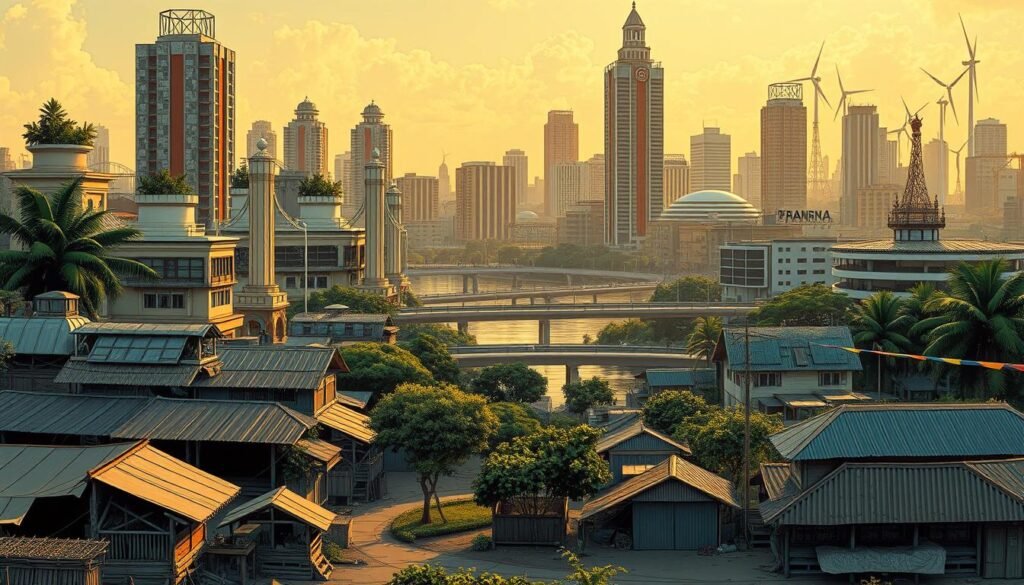
Community Initiatives and Grassroots Movements
Local communities are at the forefront of resilience efforts. Grassroots movements, such as mangrove reforestation and coastal clean-up drives, have shown remarkable success. These programs not only protect ecosystems but also empower residents to take ownership of their environment.
For example, in Leyte, community-led initiatives have restored degraded lands and improved flood defenses. Such efforts highlight the importance of local action in addressing climate challenges. By engaging customers and stakeholders, these programs create a ripple effect that benefits entire regions.
Government Policies and Strategic Programs
At the national level, the Philippine government has implemented policies to enhance resilience. The Disaster Risk Reduction and Management Reform Agenda focuses on strengthening risk-informed planning and capacity development. Local governments are mandated to allocate at least 5% of their revenue to disaster management, ensuring resources are available for critical needs.
Strategic programs, such as the Local Resilience Readiness Monitoring Framework, are being rolled out across 49 local government units. These initiatives integrate environmental planning with sustainable growth, creating a foundation for long-term resilience. Collaboration with international partners, like the Agence Française de Développement, further supports these efforts.
By combining local action with national policies, the Philippines is building a comprehensive approach to climate resilience. These strategies not only protect communities but also pave the way for a more sustainable future.
Innovative Adaptation Techniques and Sustainability Programs
Innovative solutions are transforming how the Philippines tackles climate challenges. From advanced technology to renewable energy, these efforts are paving the way for a more resilient future. By leveraging modern tools and sustainable practices, the country is addressing environmental changes head-on.
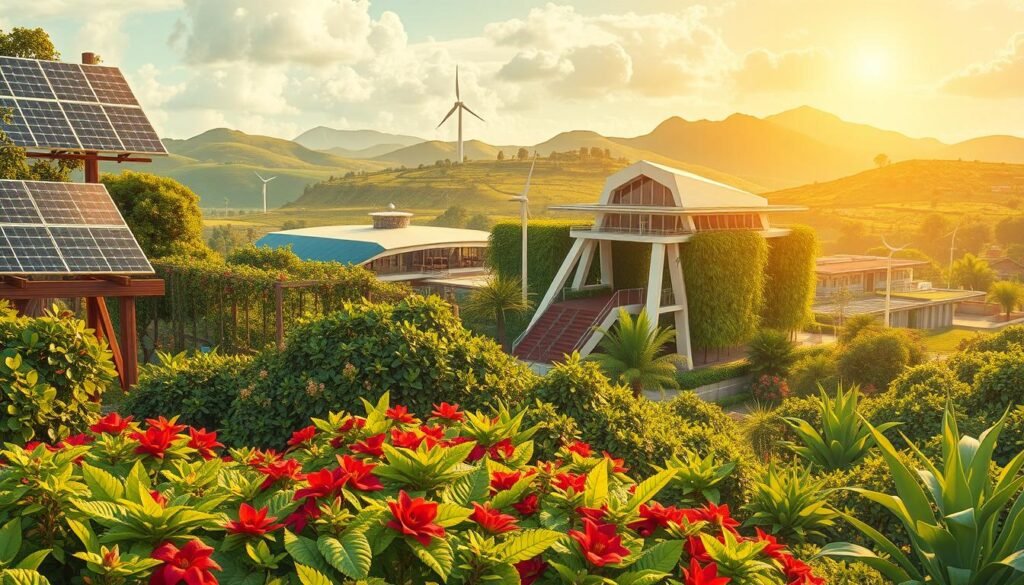
Technology Adoption for Climate Monitoring
Modern technology is revolutionizing climate monitoring in the Philippines. Innovative platforms are being used to track weather patterns, predict disasters, and analyze environmental data. For example, AI and big data are helping forecast risks like floods and droughts with greater accuracy.
Drones are another game-changer, providing real-time surveillance during disasters. These tools not only improve response times but also empower communities to prepare better. By adopting these technologies, the Philippines is building a more proactive approach to climate challenges.
Renewable Energy and Sustainable Practices
Renewable energy is at the forefront of sustainable solutions in the Philippines. Solar, wind, and hydroelectric power are reducing reliance on fossil fuels and cutting carbon emissions. These initiatives are driving energy independence and creating greener communities.
Local programs, such as mangrove reforestation and coastal clean-ups, are also making a difference. These efforts protect ecosystems while promoting sustainable livelihoods. Together, they highlight the importance of combining technology with community action.
By embracing these innovative techniques, the Philippines is setting an example for climate resilience. These strategies not only address current challenges but also pave the way for a sustainable future.
Learning from Global and Local Case Studies
Examining global and local case studies offers valuable insights into climate resilience. By analyzing successful initiatives, the Philippines can adopt strategies that address its unique challenges. This section explores both local and international examples to highlight effective approaches.

Successful Filipino Climate Initiatives
Local communities in the Philippines have implemented innovative programs to combat climate change. For example, mangrove reforestation projects in Leyte have restored ecosystems and improved flood defenses. These grassroots efforts demonstrate the power of community-driven solutions.
Another notable initiative is the use of solar-powered irrigation systems in farming communities. This technology not only reduces carbon emissions but also ensures sustainable water management. Such programs highlight the importance of combining traditional knowledge with modern tools.
Comparative Global Insights for Effective Strategies
Global case studies provide a broader perspective on climate resilience. Countries like the Netherlands have excelled in flood management through advanced engineering and community engagement. These strategies can be adapted to the Philippines’ coastal regions.
Similarly, Japan’s disaster preparedness programs offer valuable lessons. By integrating early warning systems and public education, the country has minimized the impact of natural disasters. These examples emphasize the need for collaborative learning and innovation.
Tracking the outcomes of these initiatives is crucial for continuous improvement. By monitoring progress, policymakers can refine strategies and allocate resources more effectively. This approach ensures long-term sustainability and resilience.
Leveraging Digital Tools and Data Analytics in Climate Management
Digital tools are revolutionizing how the Philippines manages climate challenges. By integrating advanced technology, the country is better equipped to monitor environmental changes and make informed decisions. These innovations are essential for building resilience and ensuring long-term sustainability.
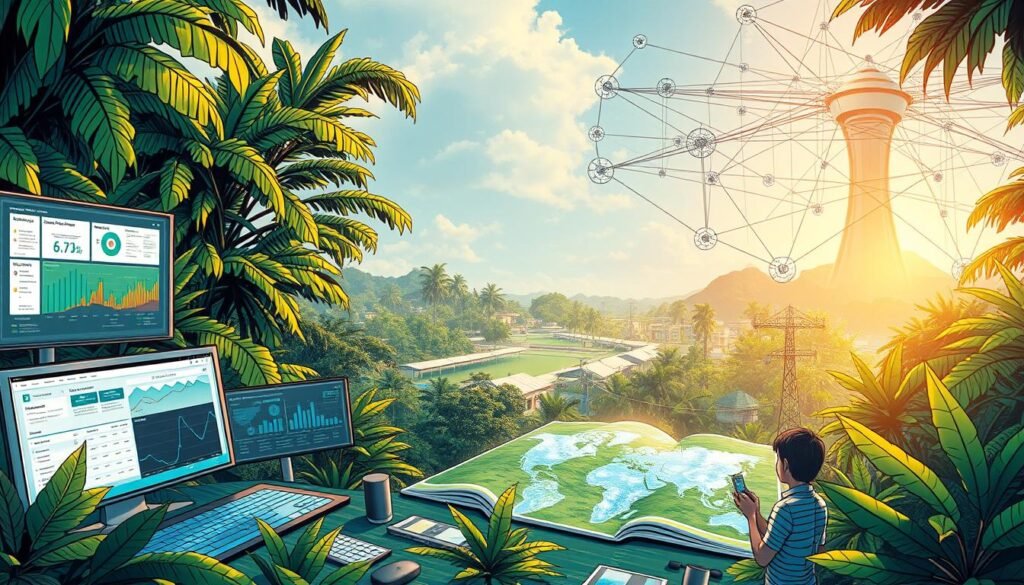
Comprehensive Tracking of Environmental Changes
Digital tools play a critical role in tracking climate patterns and environmental shifts. Platforms similar to those used for customer journey analytics are now adapted for climate monitoring. These systems provide real-time data, enabling teams to respond quickly to emerging risks.
For example, AI-powered platforms analyze vast datasets to predict floods and droughts. This proactive approach helps communities prepare and reduces the impact of disasters. By leveraging these tools, the Philippines is setting a benchmark for effective climate management.
Utilizing GIS and Satellite Monitoring Systems
Geographic Information Systems (GIS) and satellite monitoring are transforming how climate data is gathered. These technologies offer precise insights into environmental changes, such as deforestation and coastal erosion. They also enhance decision-making by providing accurate, up-to-date information.
Compared to traditional methods, GIS and satellite systems are more efficient and reliable. For instance, drones provide real-time surveillance during disasters, improving response times. These advancements empower teams to manage complex data and implement targeted strategies.
By combining technology with cross-disciplinary collaboration, the Philippines is addressing climate challenges effectively. This approach not only improves resilience but also paves the way for a sustainable future. For more insights, explore how leveraging AI and data analytics can further enhance climate management.
The Intersection of Climate Change and Economic Growth
The Philippines faces a critical challenge in aligning economic growth with environmental sustainability. Climate change disrupts traditional industries while opening doors for innovative solutions. Balancing these priorities is essential for long-term prosperity.
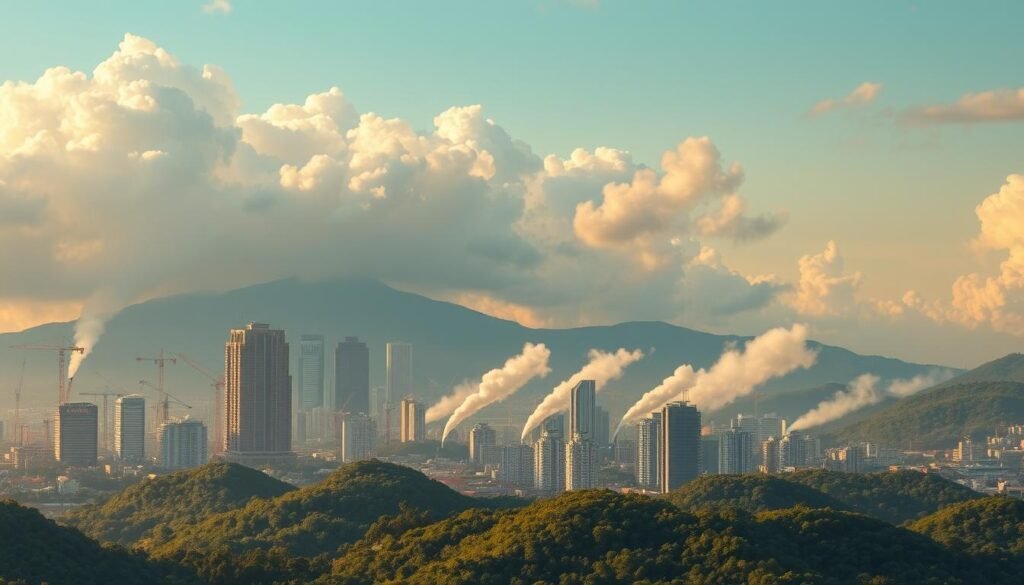
Challenges and Opportunities in Sustainable Development
Climate change poses significant risks to the Philippine economy. Rising temperatures and extreme weather events threaten agriculture, tourism, and infrastructure. However, these challenges also create opportunities for sustainable development.
For example, renewable energy projects are generating new revenue streams while reducing carbon emissions. Eco-tourism initiatives are preserving natural resources while boosting local economies. These efforts demonstrate how environmental protection can drive economic growth.
Balancing Industry and Environmental Protection
Industrial development is crucial for economic progress, but it must be balanced with environmental protection. Many industries are adopting eco-friendly practices to minimize their carbon footprint. For instance, manufacturing companies are using energy-efficient devices to reduce waste and costs.
Agricultural sectors are implementing sustainable farming techniques to improve yields and conserve resources. These practices not only protect the environment but also enhance long-term profitability. By integrating sustainability into their strategies, businesses can achieve both economic and environmental goals.
Economic Benefits of Sustainable Solutions
Adopting sustainable technologies offers significant economic benefits. Solar and wind energy projects are creating jobs and reducing reliance on fossil fuels. Green building designs are lowering operational costs while improving energy efficiency.
Investing in sustainable solutions also attracts international funding and partnerships. For example, the Philippines has secured grants for climate resilience projects from global organizations. These initiatives not only address environmental challenges but also stimulate economic growth.
To learn more about the economic impacts of climate change, explore how climate change affects economies globally.
By harmonizing economic development with environmental sustainability, the Philippines can build a resilient and prosperous future. This approach ensures that growth benefits both people and the planet.
Communicating Climate Strategies through Marketing and Engagement
Effective communication is key to driving climate action in the Philippines. By leveraging marketing and engagement strategies, organizations can shape public perceptions and inspire collective efforts. This section explores how targeted messaging and innovative outreach can enhance climate literacy and drive meaningful change.
Effective Outreach and Public Awareness Campaigns
Public awareness campaigns are essential for educating communities about climate risks and solutions. Successful campaigns often use clear, relatable messaging to connect with diverse audiences. For example, the brand “CoolBiz” in Japan reduced CO2 emissions by 1.4 million tonnes since 2005 through simple, actionable steps.
In the Philippines, campaigns like mangrove reforestation drives have shown significant results. These initiatives not only protect ecosystems but also engage local communities. By highlighting co-benefits, such as improved livelihoods, these campaigns foster long-term commitment.
Using Social Media to Drive Climate Literacy
Social media platforms are powerful tools for enhancing climate literacy. They allow organizations to reach a wide audience with engaging content. For instance, visual storytelling on platforms like Instagram and Facebook can increase traffic to climate action resources.
Targeted ads and interactive posts can also drive engagement. A study found that showing neighbors with solar panels increased adoption rates by 44%. This demonstrates the potential of social media to inspire real-world action.
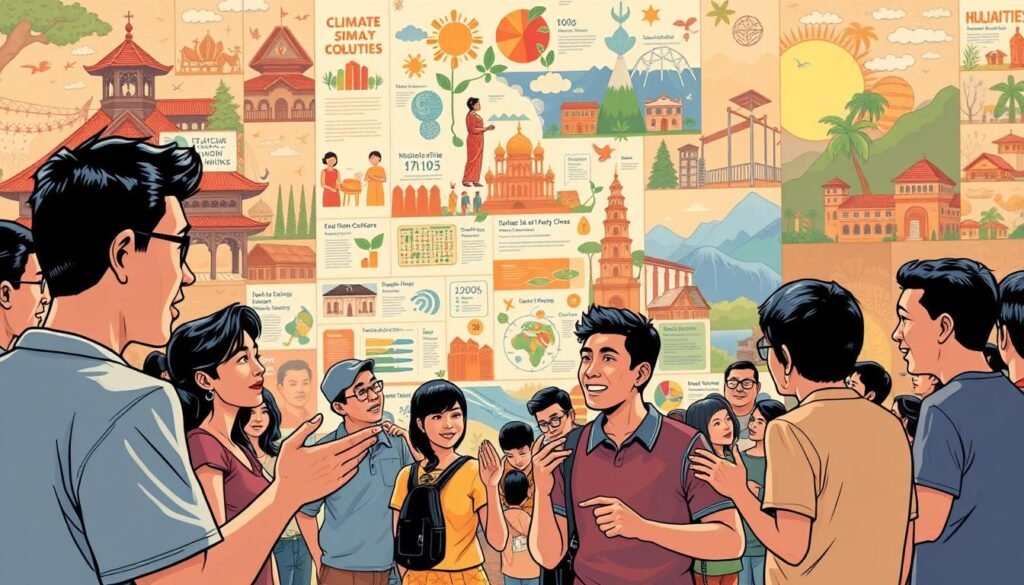
| Campaign | Platform | Result |
|---|---|---|
| CoolBiz | National Campaign | 1.4M tonnes CO2 reduction |
| Mangrove Reforestation | Community Drives | Improved flood defenses |
| Solar Panel Adoption | Social Media | 44% increase in installations |
By combining traditional outreach with digital tools, the Philippines can build a more informed and engaged society. For more insights, explore how public health and climate communication intersect.
Building Strategic Partnerships for Climate Resilience
Strategic partnerships are reshaping the fight against climate change in the Philippines, bringing together diverse stakeholders for a common goal. By uniting NGOs, private sectors, and communities, these collaborations amplify efforts to address environmental challenges. Such partnerships not only enhance resource sharing but also drive innovative solutions for long-term resilience.
Collaborations between NGOs, Private Sector, and Communities
Local NGOs play a crucial role in bridging gaps between communities and larger organizations. For instance, partnerships between environmental NGOs and private companies have led to successful mangrove reforestation projects. These initiatives not only restore ecosystems but also provide livelihoods for coastal communities.
Private sector participation is equally vital. Companies are endorsing climate initiatives by investing in renewable energy and sustainable practices. These efforts demonstrate how businesses can contribute to environmental protection while improving their performance.
International and Cross-Sector Partnerships
International collaborations bring global expertise and funding to local projects. For example, partnerships with organizations like the Agence Française de Développement have supported disaster risk reduction programs in the Philippines. These cross-sector efforts enhance the experience of local teams and improve project outcomes.
Case studies show measurable improvements from these partnerships. In Leyte, community-led initiatives supported by international funding have restored degraded lands and improved flood defenses. Such successes highlight the importance of strategic alliances in climate resilience work.
| Partnership | Focus Area | Outcome |
|---|---|---|
| NGO-Private Sector | Mangrove Reforestation | Restored ecosystems, improved livelihoods |
| International Collaboration | Disaster Risk Reduction | Enhanced community resilience |
| Cross-Sector Initiative | Renewable Energy | Reduced carbon emissions, energy independence |
By fostering these partnerships, the Philippines is building a more resilient future. To learn more about how strategic business partnerships can combat climate change, explore this insightful resource.
Navigating Challenges: Adaptation and Mitigation Roadmaps
Adapting to climate change in the Philippines requires a structured roadmap to address its unique challenges. Rising temperatures, extreme weather, and sea-level rise demand proactive strategies to protect communities and ecosystems. By focusing on adaptation and mitigation, the country can build resilience and ensure long-term sustainability.
Major Challenges in Adaptation and Mitigation
The Philippines faces several obstacles in its climate adaptation efforts. Limited resources, fragmented policies, and a lack of public awareness often hinder progress. Coastal communities are particularly vulnerable, with rising sea levels threatening livelihoods and infrastructure.
Another challenge is the need for skill development among local teams. Training programs are essential to equip communities with the knowledge to implement effective adaptation strategies. Addressing these challenges requires collaboration between governments, NGOs, and private sectors.
Designing and Implementing Adaptation Roadmaps
Creating effective adaptation roadmaps involves several key steps. First, stakeholders must assess local vulnerabilities and identify priority areas. This includes analyzing climate risks, such as flooding and drought, and understanding their potential impact.
Next, actionable plans should be developed, integrating both short-term and long-term goals. For example, mangrove reforestation projects can provide immediate flood protection while restoring ecosystems over time. These plans must also include monitoring systems to track progress and adjust strategies as needed.
Evaluating the Success of Adaptation Plans
Measuring the effectiveness of adaptation efforts is crucial. Metrics such as reduced disaster risks, improved community resilience, and enhanced ecosystem health can provide valuable insights. For instance, successful projects often show a decrease in flood damage or an increase in agricultural yields.
Continuous evaluation ensures that resources are used efficiently and that strategies remain relevant. By learning from past successes and failures, the Philippines can refine its approach to climate adaptation.
Building Skills and Continuous Learning
Developing the necessary skills within teams is essential for long-term success. Training programs should focus on climate science, risk management, and sustainable practices. Empowering local communities with these skills ensures that adaptation efforts are sustainable and locally driven.
Up-to-date content and resources also play a critical role. Access to the latest research and best practices helps teams stay informed and adapt to new challenges. Starting today, continuous learning should be a cornerstone of all climate initiatives.
Supporting Mitigation Efforts with Updated Content
Effective mitigation requires integrating the latest content into planning and implementation. This includes data on renewable energy, sustainable agriculture, and disaster preparedness. By staying informed, teams can make better decisions and achieve measurable results.
For example, integrating risk and asset management principles, as outlined in this study, can enhance decision-making and build resilience against climate-related challenges. These strategies ensure that mitigation efforts are both effective and sustainable.
By addressing these challenges and implementing structured roadmaps, the Philippines can navigate the complexities of climate change. Building resilience today ensures a safer and more sustainable future for all.
Future Projections and Long-Term Climate Strategy Development
The Philippines must prepare for a future shaped by evolving climate patterns. Rising temperatures, extreme weather, and sea-level rise are expected to intensify, posing significant risks to communities and ecosystems. Developing long-term strategies is essential to ensure resilience and sustainability.
Forecasting Climate Trends and Risks
Climate models predict a 1.5°C to 2°C temperature rise in the Philippines by 2050. This increase will likely lead to more frequent and severe typhoons, prolonged droughts, and coastal flooding. These trends threaten agriculture, infrastructure, and public health.
For example, projections indicate that sea levels could rise by 0.5 meters by 2100, displacing millions in coastal areas. Understanding these risks is critical for designing effective adaptation measures. By integrating forecasting tools, the Philippines can better prepare for these challenges.
Strategic Planning for National Resilience
Long-term resilience requires a comprehensive approach. The Philippine government is developing strategic plans to address climate risks. These include strengthening infrastructure, enhancing disaster response systems, and promoting sustainable practices.
Investing in renewable energy and ecosystem restoration is a key part of this strategy. These efforts not only reduce carbon emissions but also provide economic value by creating jobs and protecting livelihoods. A well-defined course of action ensures that resources are used efficiently.
| Initiative | Focus Area | Expected ROI |
|---|---|---|
| Renewable Energy Projects | Solar, Wind, Hydro | High |
| Mangrove Reforestation | Coastal Protection | Medium |
| Disaster Preparedness Programs | Community Resilience | High |
Evaluating the roi of these initiatives is crucial for sustained success. By focusing on measurable outcomes, the Philippines can ensure that its climate strategies deliver long-term benefits. This approach not only addresses current challenges but also paves the way for a sustainable future.
Conclusion
Addressing climate change in the Philippines demands a unified approach. Throughout this article, we’ve explored the pressing challenges and the trends shaping the nation’s response. From rising temperatures to extreme weather, the need for resilient strategies is undeniable.
Integrated solutions, such as technology adoption and strategic partnerships, play a vital role. Effective messaging also drives public awareness, encouraging communities to take action. These efforts are essential to improve the resilience rate over time.
Looking ahead, continuous engagement and adaptation are key. By staying informed and proactive, the Philippines can navigate these challenges effectively. For more insights, explore how climate-smart agriculture can further enhance sustainability.
Together, we can build a future that balances environmental protection with economic growth. Let’s take action today to ensure a resilient tomorrow.
FAQ
How has climate change historically affected the Philippines?
The Philippines has faced rising temperatures, stronger typhoons, and unpredictable weather patterns over the years. Historical data shows increased frequency of extreme weather events, impacting agriculture and communities.
What are the major health risks linked to climate change in the Philippines?
Climate change has led to higher risks of waterborne diseases, heat-related illnesses, and respiratory problems. Vulnerable communities, especially in coastal areas, are most affected.
How does climate change impact biodiversity in the Philippines?
Rising temperatures and habitat destruction threaten many species. Coral reefs, forests, and marine ecosystems face significant degradation, leading to biodiversity loss.
What role do renewable energy and sustainable practices play in climate adaptation?
Renewable energy reduces greenhouse gas emissions, while sustainable practices like reforestation and eco-friendly farming help communities adapt to changing conditions.
How are digital tools like GIS and satellite monitoring used in climate management?
These tools track environmental changes, predict weather patterns, and help in planning effective climate strategies. They provide real-time data for better decision-making.
What are some successful Filipino climate initiatives?
Programs like mangrove reforestation, community-based disaster risk reduction, and renewable energy projects have shown positive results in building resilience.
How can social media drive climate literacy in the Philippines?
Social media platforms raise awareness, share educational content, and engage the public in climate action. They help spread information quickly and effectively.
What are the economic challenges of balancing development with sustainability?
Rapid development often leads to environmental degradation. Balancing growth with sustainability requires innovative policies and investments in green technologies.
How do international partnerships support climate resilience in the Philippines?
Collaborations with global organizations bring funding, expertise, and technology. These partnerships enhance local efforts to combat climate change.
What are the long-term strategies for national climate resilience?
Long-term strategies include forecasting climate trends, investing in infrastructure, and implementing policies that promote sustainable development and community preparedness.
Source Links
- Challenging the Change: The Growing Impact of Climate Change on PH Food Security and Livelihoods
- Climate Change Impacts Severely Impede SDGs, Says ADB–UN Report
- Climate change in the Philippines
- How is climate change affecting the Philippines?
- Getting a Grip on Climate Change in the Philippines
- Leaving No Women Behind: Evaluating the Impact of the COVID-19 Pandemic on Livelihood Outcomes in Kenya and Ethiopia
- The impact of COVID-19 on livelihood assets: a case study of high-value crop farmers in North-West Bangladesh – Scientific Reports
- Climate change and environmental degradation
- Biodiversity – our strongest natural defense against climate change | United Nations
- Land – the planet’s carbon sink | United Nations
- Empowering local governments for effective disaster management and climate resilience
- Global research trends in Environmental adaptation techniques focusing on climate change through scientometric lens – Discover Sustainability
- 5 innovations helping the world adapt to climate change
- New insights in flood risk management: learning from global case studies of stakeholder partnerships
- Frontiers | The impact of food poverty on educational achievement: a New Zealand case study in global context
- Leveraging data and Artificial Intelligence for climate-smart decision-making in government
- Leveraging technology and innovation to address climate change risks
- Social Dimensions of Climate Change
- Frontiers | Environmental protection or economic growth? The effects of preferences for individual freedoms
- Communicating on Climate Change | United Nations
- Sustainability Comms 101: Mastering Climate Communications for Green Behaviour Change
- Advancing climate action. Building resilience.
- Generate strategic value by building climate resilience
- What is climate change adaptation and why is it crucial? | UNDP Climate Promise
- Advancing Local Sea Level Rise Adaptation « Adapting to Rising Tides
- Climate Change – United Nations Sustainable Development
- What Is a Long-term Strategy?
- CONCLUSION: THE IMPACT OF THE CRUSADES | 24 | v2 | The Crusades, 1095-
- Conclusion

